Disorders in the structure of the spine, pathological changes in the vertebrae, deterioration of blood supply and metabolism are obvious clinical manifestations. degenerative-dystrophic changes in the main body of the human skeleton.
These changes are mainly associated with the age-related characteristics of the spinal column. As a rule, this pathology is diagnosed in older people. But the initial changes in the structure of the vertebrae can be seen already at a young age, especially if the patient already has spinal diseases (for example, scoliosis).
This pathology leads to the formation of hernias, protrusions, osteophytes and thinning of the intervertebral discs, and disruption of blood supply.
Record content:
- 1 Views
- 2 Stages and degrees
- 3 Symptoms
- 4 Reasons for the appearance
- 5 Diagnostics
- 6 When to see a doctor
- 7 Prophylaxis
-
8 Treatment methods
- 8.1 Medications
- 8.2 Traditional methods
- 8.3 Other methods
- 9 Possible complications
- 10 Video about degenerative-dystrophic changes in the spine
Views
Degenerative-dystrophic changes in the spine are pathologies that can affect almost the entire spine.
In this regard, several types of lesions are distinguished, depending on the location:
- Changes in the cervical spine.
- Changes in the thoracic spine.
- Changes in the lumbar spine.
- Changes in the sacral spine.
The occurrence of pathological changes in the spinal column is closely related to the progression of the following diseases:
- Osteochondrosis. It is a chronic disease of the spinal column characterized by premature thinning of the spinal discs. It occurs mainly in the elderly, but recently such a pathology has been diagnosed at a younger age. The initial signs of osteochondrosis can be seen when performing an X-ray at the age of 20-25 years.
-
Osteoarthritis. It is a disease of the spine, which manifests itself in the form of damage and destruction of articular cartilage and the development of osteophytes. The most common osteoarthritis of the cervical spine.
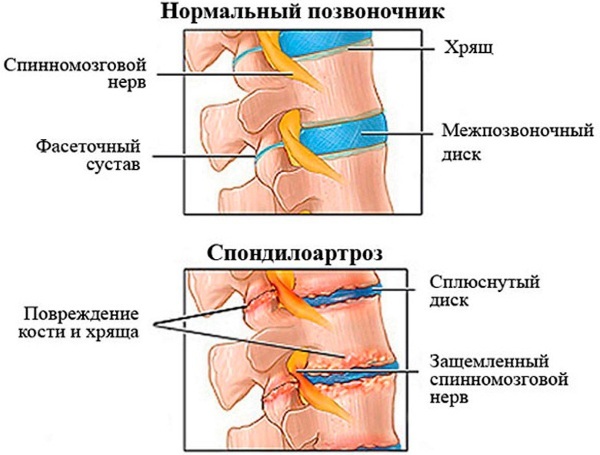
- Spondyloarthrosis. It is a form of osteoarthritis and affects all elements of the joint, namely, cartilage, ligaments, capsules and periarticular muscles.
Stages and degrees
Degenerative-dystrophic changes in the spine is a pathology that has 4 stages (degrees) of development:
- At this stage, the disturbances are still invisible, there are no symptoms. In the intervertebral discs, their elasticity is reduced, and slight deformation occurs.
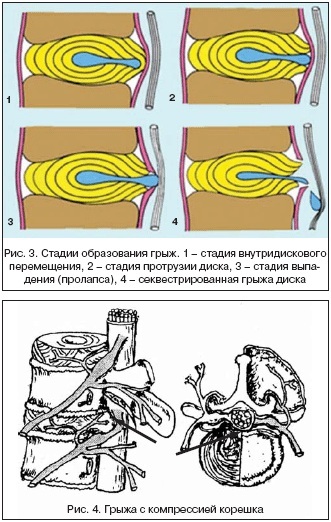
Degenerative-dystrophic changes in the spine. Stages - Disorders in the spine gradually progress, there is a weakening of the ligaments, possibly compression of the nerve roots. Thus, at this stage, a rather pronounced pain syndrome appears.
- Along with the infringement of the nerve roots, disturbances occur in the blood supply to the spinal column. There is an increase in neurological symptoms.
- At the fourth stage, the progression of the disease can no longer be stopped, thereby leading to complications and a complete disruption of blood supply and innervation in the spinal column.
Symptoms
The clinical picture of changes in the spine is diverse and includes the following symptoms:
- Pain in the affected spinal column. It is chronic. The pain intensifies when the patient takes an uncomfortable posture, physical exertion, and long walking. For a long time, the pain syndrome does not make itself felt in any way, or there may be minor pain sensations.
- Restriction of the mobility of the affected area.
- Tingling or numbness in the limbs, creeping sensation, burning of the skin.
- Headache.

- Dizziness (with damage to the cervical spine).
- Cramps in the calf muscles.
- Visual impairment, double vision.
- Pain when raising the leg in a straight position.
- Pain with a deep breath (without pathology of the respiratory system).
- Pain in the region of the heart (no changes on the ECG).
Reasons for the appearance
The reasons for the development of this pathology are varied and are divided as follows:
| Department | Symptoms |
| Cervical |
|
| Thoracic department |
|
| Lumbar |
|
Sacral region |
|
Diagnostics
The main diagnostic techniques are a thorough collection of the patient's history and examination. The doctor then prescribes additional diagnostic methods for the patient, which usually include X-ray or MRI. X-rays are performed in two projections, frontal and straight.
In case of violations in the spinal column, the following signs will be noticed:
- Osteophyte formation.
- The shortened height of the intervertebral discs and their deformation.
- Subluxation of the vertebral bodies.
- Concomitant pathologies (scoliosis, kyphosis).
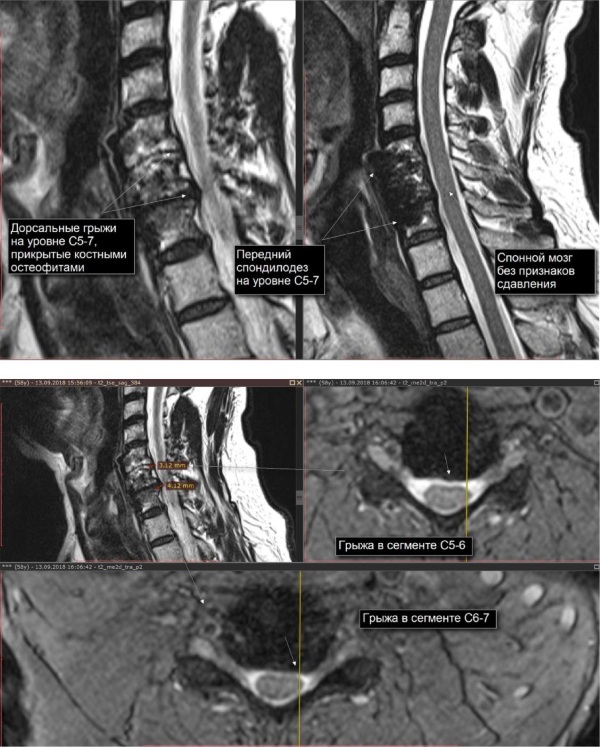
X-ray is the most popular method for diagnosing diseases of the spinal column, but sometimes it does not give a detailed picture of pathological changes. Therefore, for a more accurate diagnosis, MRI is performed.
MRI is an informative way of examining the spine, with the help of which it is possible to identify not only pathological changes in the spinal column (protrusions, hernias, compression fractures), but also the condition of the nerves and blood vessels supplying vertebrae.
With the help of MRI you can see:
- The presence of intervertebral hernias.
- Intervertebral disc protrusion.
- Breaks in the annulus fibrosus.
- Compression of the intervertebral nerves.
Degenerative-dystrophic changes are best diagnosed by MRI - research. This study allows you to get a fairly clear picture of the state of the spinal column and determine if there are concomitant diseases.
The cost of diagnostic procedures in different cities differs, but, as a rule, the price of an MRI examination of one section of the spine ranges from 4000 to 5000 rubles. And also you can undergo a spinal examination under the compulsory medical insurance policy.
The procedure is performed both in private medical centers and in public medical institutions.
When to see a doctor
The initial symptoms of diseases are usually invisible. Since the pain syndrome develops gradually, a person usually seeks a doctor when the changes become more noticeable, and the pain syndrome is more pronounced. This does not occur at the first stage of pathological changes.
It is necessary to consult a doctor at the first disturbing symptoms, which include even a slight pain syndrome, dizziness, and a feeling of "goose bumps" on the skin.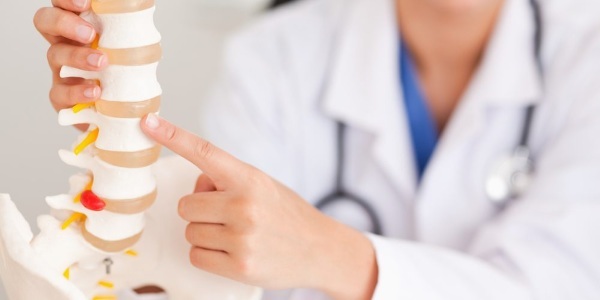
The diagnosis and treatment of diseases of the spinal column is carried out by a neurologist. He prescribes treatment and, if necessary, additional diagnostic measures.
If additional diseases were identified during the diagnosis, the doctor refers the patient to a specialist doctor for consultation. If there is a need for surgery, it is necessary to consult a neurosurgeon.
Prophylaxis
Prevention of these diseases is very similar to preventive measures for other diseases of the musculoskeletal system and include:
- Rational physical activity. These include doing morning exercises, therapeutic walking, and running. You need to do physical exercises gradually, increasing the exercise time every day.
- Balanced diet. The diet should contain a sufficient amount of proteins, trace elements (calcium, magnesium), vitamins. For people with spinal diseases, the diet should include low-fat fish, nuts, berries, fruits, legumes, dairy products and eggs.
- Maintaining optimal body weight.
- Quitting bad habits (smoking and alcohol).
- Choosing the right mattress for your sleeping place. For people with diseases of the musculoskeletal system, the best option is an orthopedic mattress, which will help maintain the spine in the correct position.
- Maintaining correct posture.
Treatment methods
Degenerative-dystrophic changes in the spine are diseases that are treated in a comprehensive manner. The method of treatment is determined depending on the stage of the disease, well-being and age of the patient.
First of all, you need to pay attention to pain relief, restoration of normal blood supply in the spinal column. For this, drug therapy and other methods of treating diseases of the spine are used.
Medications
-
Pain relieving anti-inflammatory drugs (NSAIDs). To relieve pain, intramuscular administration of drugs is used - Diclofenac - 25 mg (3 ml) 2 times a day. It is also possible to use oral medications (Diclofenac, Nise) or the use of ointments with an anti-inflammatory effect (Nise, Ketoprofen). These drugs have analgesic and anti-inflammatory effects.

- Chondroprotectors. These are drugs that keep the cartilage tissue in a normal state and prevent further destruction (Chondroitin, Teraflex). They are also available as oral tablets and ointments. If the drug is in the form of tablets, then in this case, a single dose is 1 g of the drug 2 times a day. In the form of ointments, the drug is applied 2 times a day in a thin layer, at night. The course of treatment is from two weeks to a month.
- Muscle relaxants. The drugs are used to relieve muscle spasms. The drug Mydocalm is widely used. Dosage forms are presented in the form of tablets and solution for intramuscular administration. To stop the spasm, as a rule, intramuscular administration of the drug is prescribed, 1 ml once a day. The course of treatment is 5 days.
- Sedatives with an unstable state of the nervous system, problems with sleep. You can use light sedatives based on medicinal plants (valerian, motherwort). In some cases, you may need to take more powerful sedatives, for example, drugs from the diazepam group (Phenozepam).
- B vitamins. A frequently prescribed drug for diseases of the musculoskeletal system is Milgamma. The drug is injected intramuscularly 2 ml 2 times a day (morning and evening). The course of treatment is 7 to 10 days. If necessary, the doctor can extend the course of treatment or transfer the patient to maintenance therapy (injections of the drug once every 2 weeks).
Traditional methods
When treating with folk remedies, they often resort to sessile methods:
- The use of compresses. Compresses can be made from grated potatoes and honey. To do this, raw potatoes are warmed up to about + 50 ℃, warm honey is added to it and a cake is formed. Then they spread it on a napkin, after which they apply the affected area. The duration of exposure is 1 hour. You can repeat the procedure until the pain disappears completely.
-
Ointment from medicinal plants. You can use nettle seeds to make the ointment. They add 100 ml of water and 2 tbsp. l. petroleum jelly, then everything is thoroughly kneaded until smooth. The ointment should be infused for several days. After that, the ointment can be used. As a rule, the ointment is applied once a day for 10 to 14 days or until the pain completely disappears.

- Lingonberry infusion. In order to prepare such an infusion, you need to take 1 tbsp. l. lingonberry leaves, chop them and pour boiling water over them. After that, let it brew for 1 hour. You need to take the infusion 2 times a day for two weeks. For each new technique, you need to prepare a fresh infusion. And you can also prepare an infusion of lingonberry berries with the addition of honey.
Other methods
Degenerative-dystrophic changes in the spine are disorders that need to be treated with additional methods, in addition to drug therapy.
These methods of treating diseases of the spine include:
- Surgery. It is prescribed when conservative therapy is ineffective or when complications develop. And also the operation is indicated for the detection of intervertebral hernias and with pronounced neurological symptoms.
- Physiotherapy methods. These include electrophoresis (with novocaine or demexidum), magnetotherapy, ultrasound treatment, paraffin applications. Physiotherapy is used with the main treatments. The course of procedures depends on the severity of the pathology, as a rule, takes a time interval from 14 days to 1 month.
- Acupuncture. It is an effect on biologically active points by introducing long or short needles, which are left to act for 30 minutes.
- Massotherapy. It is one of the main methods of pain relief. It helps to relax the back muscles, improve blood supply, and maintain muscle tone. The massage course is usually 1 month.
- Physiotherapy. It is a mandatory method in the treatment of patients with diseases of the spine. It is necessary to start the treatment procedure after reducing pain. But individual methods of exercise therapy can be carried out at the very beginning of treatment. The choice of exercises and the degree of their load on the patient's body is chosen by the doctor or nurse of the exercise therapy room.
- The use of orthopedic corsets. To reduce pain and unload the musculoskeletal system, you can use special corsets. Usually a corset is used for the lumbar spine. It supports the spine in the correct position, relieves pain and the degree of stress. These corsets are worn for 2 months. Sometimes this gap can stretch up to 6 months. There is a certain time of wearing corsets during the day. You do not need to wear a corset constantly, during the day it is worn for 4 hours, then removed. The duration of use is determined by the doctor.
Possible complications
If pathological changes in the spine are not diagnosed in time or treated incorrectly, the following complications may develop:
-
Intervertebral hernia. This pathology is formed asymptomatically and remains unattended for a long time. This pathology can lead to neurological disorders and disabilities. Surgical hernia treatment.
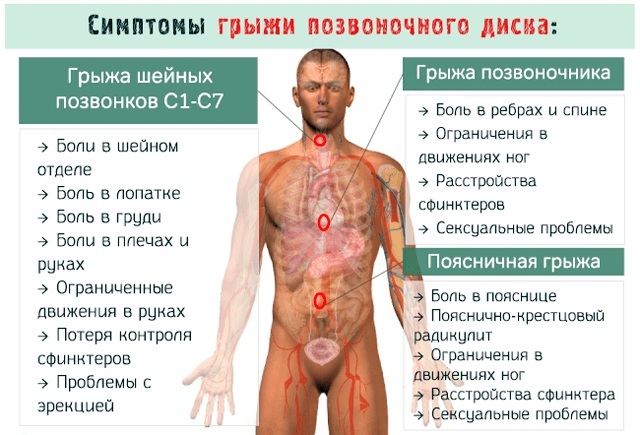
- Scoliosis. It is a curvature of the spinal column. There are lateral forms of scoliosis and S-shaped. Such a pathology can threaten with disorders of the respiratory and cardiovascular systems, since the chest is deformed together with the spinal column. Scoliosis treatment depends on the severity.
- Chronic back pain. This is due to the clamping of the nerve roots.
- The risk of developing fractures in the spine. This is due to the thinning of the structures of the spine.
- Paresis. This dangerous complication is associated with damage to the nerve fibers located in the spine. In this regard, a gradual decrease in the patient's muscle strength develops.
- Intercostal neuralgia. It is characterized by periodic pain that occurs along the intercostal nerves. It is accompanied by pronounced painful sensations, burning sensations and "crawling creeps." Attacks can be so striking that they can be confused with myocardial infarction.
- Spinal cord compression. It develops gradually, along with the progression of the pathology of the spine. As a result, the patient's disability is possible.
The prognosis for degenerative-dystrophic changes in the spine is usually favorable. It depends on the timely started treatment and the severity of the pathology. In most cases, it is possible to significantly improve the quality of life of patients and significantly reduce the risk of developing possible complications.
Video about degenerative-dystrophic changes in the spine
Degenerative diseases of the spine:



